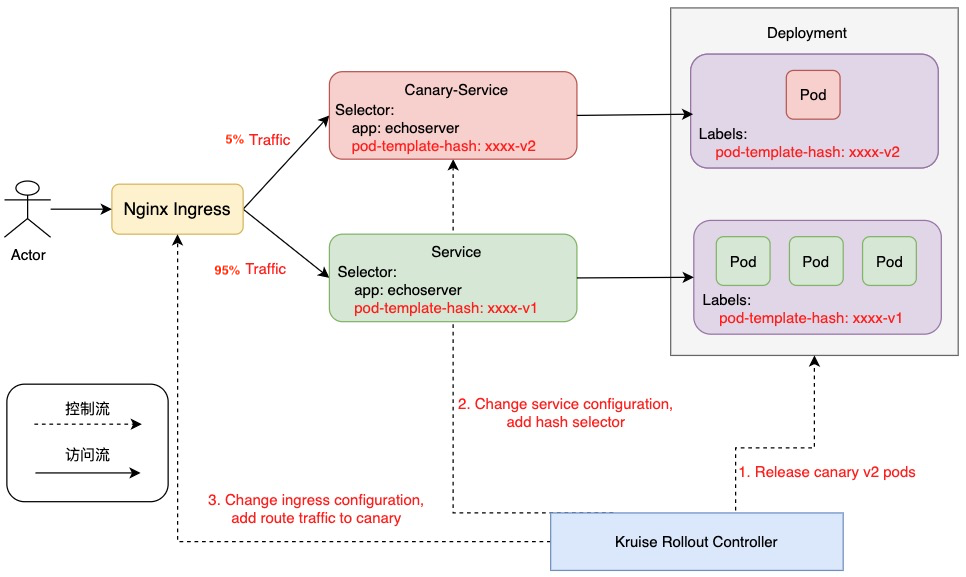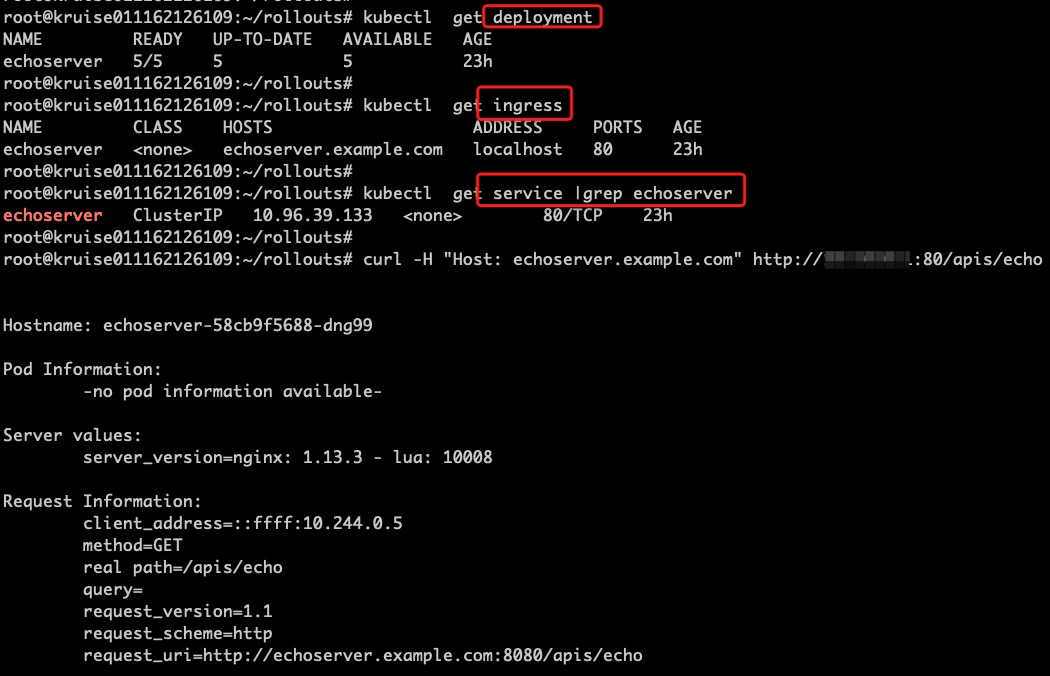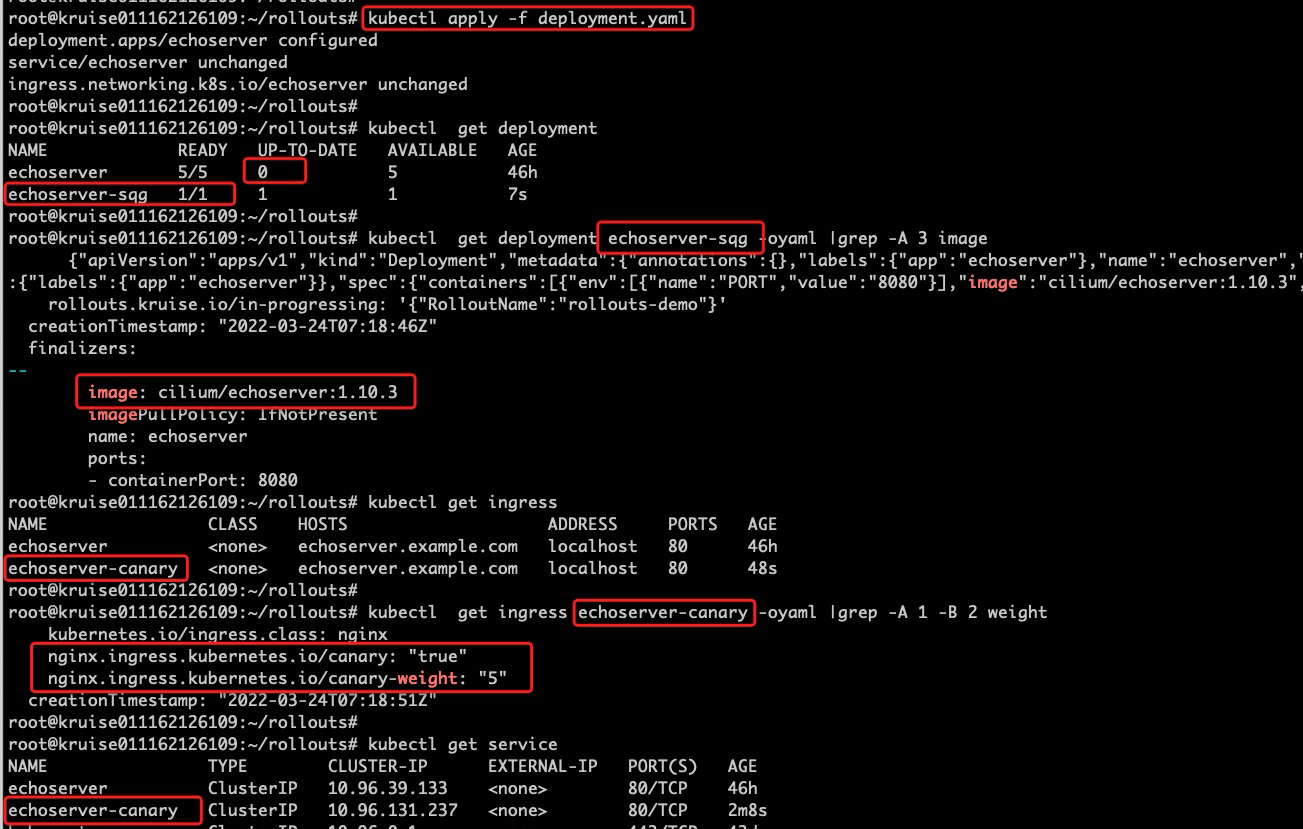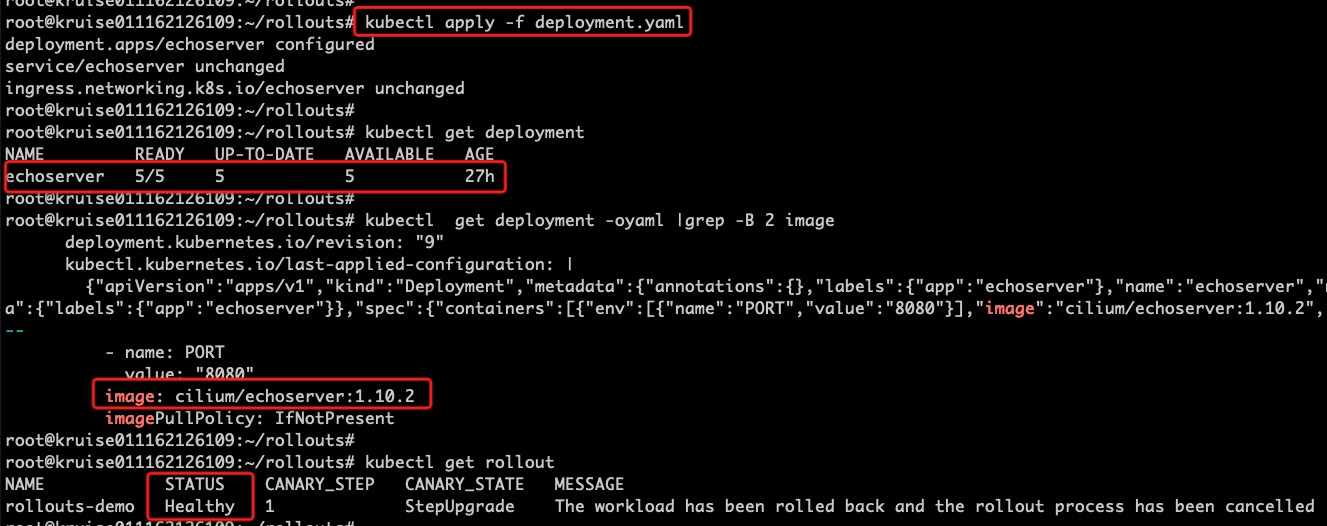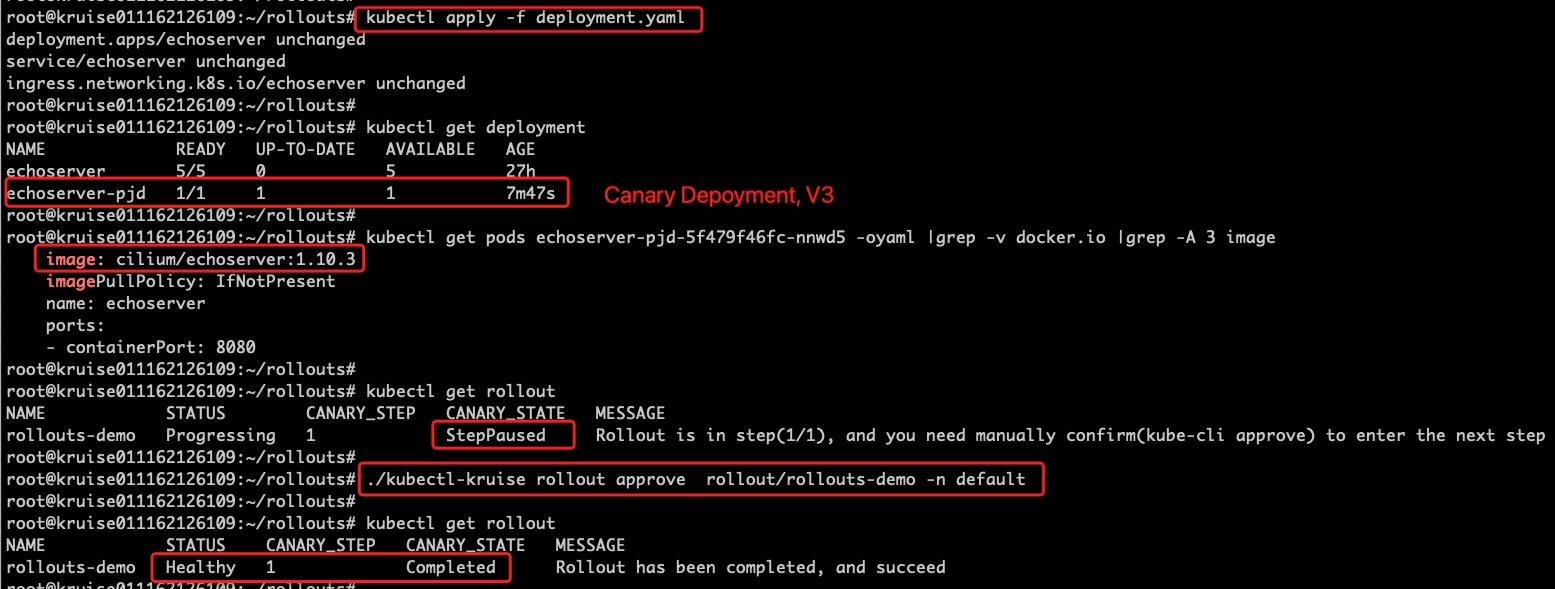6.5 KiB
Basic Usage
This guide will demonstrate various concepts and features of Kruise Rollout by going through Canary Release, Deployment, Nginx Ingress.
Requirements
- Helm installation of Kruise Rollout, Reference Install Kruise Rollout.
- Helm installation of Nginx Ingress Controller, (e.g. helm upgrade --install ingress-nginx ingress-nginx --repo https://kubernetes.github.io/ingress-nginx --namespace ingress-nginx)
1. Deploy Business Application (Contains Deployment, Service and Ingress)
This is an example of echoserver application, which contains ingress, service, and deployment crd resources, as follows:
apiVersion: apps/v1
kind: Deployment
metadata:
name: echoserver
labels:
app: echoserver
spec:
replicas: 5
selector:
matchLabels:
app: echoserver
template:
metadata:
labels:
app: echoserver
spec:
containers:
- name: echoserver
# mac m1 should choics image can support arm64,such as image e2eteam/echoserver:2.2-linux-arm64
image: cilium/echoserver:1.10.2
imagePullPolicy: IfNotPresent
ports:
- containerPort: 8080
env:
- name: PORT
value: '8080'
---
apiVersion: v1
kind: Service
metadata:
name: echoserver
labels:
app: echoserver
spec:
ports:
- port: 80
targetPort: 8080
protocol: TCP
name: http
selector:
app: echoserver
---
apiVersion: networking.k8s.io/v1
kind: Ingress
metadata:
name: echoserver
annotations:
kubernetes.io/ingress.class: nginx
spec:
rules:
- host: echoserver.example.com
http:
paths:
- backend:
service:
name: echoserver
port:
number: 80
path: /apis/echo
pathType: Exact
After deployed in k8s cluster, it can be accessed via nginx ingress, as follows:
2. Deploy Kruise Rollout CRD
Kruise Rollout CRD defines the deployment rollout release process, as follows is an example of canary release, the first step is 20% pods, as well as routing 5% traffics to the new version.
apiVersion: rollouts.kruise.io/v1alpha1
kind: Rollout
metadata:
name: rollouts-demo
# The rollout resource needs to be in the same namespace as the corresponding workload(deployment, cloneSet)
# namespace: xxxx
spec:
objectRef:
# rollout of published workloads, currently only supports Deployment, CloneSet
workloadRef:
apiVersion: apps/v1
kind: Deployment
name: echoserver
strategy:
canary:
# canary published, e.g. 20%, 40%, 60% ...
steps:
# routing 5% traffics to the new version
- weight: 5
# Manual confirmation of the release of the remaining pods
pause: {}
# optional, The first step of released replicas. If not set, the default is to use 'weight', as shown above is 5%.
replicas: 20%
trafficRoutings:
# echoserver service name
- service: echoserver
# echoserver ingress name, current only nginx ingress
ingress:
name: echoserver
3. Upgrade echoserver (Version 1.10.2 -> 1.10.3)
Change the image version in deployment from 1.10.2 to 1.10.3, then kubectl apply -f deployment.yaml to the k8s cluster, as follows:
apiVersion: apps/v1
kind: Deployment
metadata:
name: echoserver
...
spec:
...
containers:
- name: echoserver
# mac m1 can choice image e2eteam/echoserver:2.2-linux-arm
image: cilium/echoserver:1.10.3
imagePullPolicy: IfNotPresent
The Kruise Rollout Controller listens to the above behavior and sets deployment paused=true in the webhook, then generates the corresponding canary resources based on the user-defined deployment, service, and ingress configuration.
As shown in the figure below, replicas(5)*replicas(20%)=1 new versions of Pods are published and 5% of the traffic is routed to the new version.
4. Approve Rollout (Release Success)
The Rollout status shows that the current rollout status is StepPaused, which means that the first 20% of Pods are released success and 5% of traffic is routed to the new version.
After that, developers can use some other methods, such as prometheus metrics business metrics, to determine that the release meets expectations and then continue the subsequent releases via kubectl-kruise rollout approve rollout/rollouts-demo -n default and wait deployment release is complete, as follows:
5. Release Failure
Publish Abnormal Version
In the publishing process there are often cases of publishing failure, such as the following image pulling failure:
apiVersion: apps/v1
kind: Deployment
metadata:
name: echoserver
...
spec:
...
containers:
- name: echoserver
# image not found
image: cilium/echoserver:failed
imagePullPolicy: IfNotPresent
At this point, the rollout status remains at StepUpgrade state, and by checking the deployment and pods status, you can see that it is because the image pull failed.
a. Rollback To V1 Version
The most common way is Rollback, where you don't need to do anything with the rollout crd, only just rollback the deployment configuration to the previous version, as follows rollback the image version in deployment to 1.10.2 and kubectl apply -f to the k8s cluster.
apiVersion: apps/v1
kind: Deployment
metadata:
name: echoserver
...
spec:
...
containers:
- name: echoserver
# m1 should rollback to e2eteam/echoserver:2.2-linux-arm64
image: cilium/echoserver:1.10.2
imagePullPolicy: IfNotPresent
b. Continuous Release V3 Version
For some scenarios where you can't rollback, you can continuously release the v3 version. as follows, change the deployment image address to 1.10.3 and then kubectl apply -f to the k8s cluster. Once the publishing is complete, just perform the Approve Rollout step.
apiVersion: apps/v1
kind: Deployment
metadata:
name: echoserver
...
spec:
...
containers:
- name: echoserver
# m1 can choice image e2eteam/echoserver:2.2-linux-arm
image: cilium/echoserver:1.10.3
imagePullPolicy: IfNotPresent
